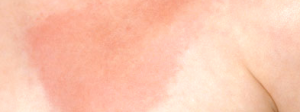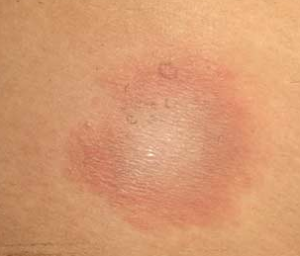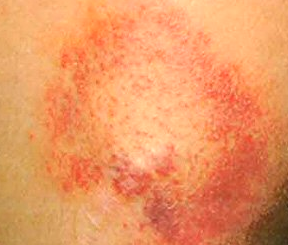Lyme disease rash is a characteristic skin rash that is circular in form and known as erythema migrans. Lyme disease rash is one of the first signs of the bacterial illness termed as Lyme disease and caused by a bacterium known as a ‘spirochete’. The bacterium is known as Borrelia burgdorferi in North America. In Europe, the bacterium Borrelia afzelii causes Lyme disease and leads to the characteristic Lyme disease rash.
Lyme disease is caused due to the bite of Deer ticks that carry the bacteria. The disease though is not contagious. Besides the symptomatic rash on the skin, Lyme disease can lead to other abnormalities and problems of the skin, heart, joints, and the nervous system.
The causes and symptoms of Lyme disease were first discovered and diagnosed in a group of several children in Lyme, Connecticut. All of these children were affected by rheumatoid arthritis. Subsequent research studies on this case revealed the illness to be caused by bacteria-carrying ticks.
Symptoms of Lyme disease rash
The occurrence of the characteristic Lyme disease rash is concurrent with and followed by the variable signs and symptoms listed below:
- The bacteria enter the body through the bite of ticks. The area where the tick-bite occurs becomes infected with the bacteria and a tiny, red bump appears on the spot. The skin infection then develops rapidly, expanding into a circular and reddish rash. This Lyme disease rash is accompanied by symptoms that are flu-like.
- The inflammation of the skin and the appearance of Lyme disease rash is the first phase of Lyme disease. The rash may disappear within a few weeks or months on its own. This brings the onset of the other phases of Lyme disease that may affect the other tissues and organs like the joints, heart and the nervous system.
- The Lyme disease rash is circular and expands in a ring like form. The rash is not raised and does not have any bumps. The outermost ring of the circular rash is a brighter red than the rest of it, with a clear patch in the center. This gives the rash a bull’s-eye like appearance. Individuals who develop the rash cannot recall a tick-bite, because the ticks are microscopic. Other individuals may develop multiple rashes as a result of the bacteria multiplying and proliferating in the blood stream.
- The lyme disease rash may result in other symptoms such as generalized or global fatigue, swollen glands, stiffness of the joints and muscles, fever, body aches, chills and headaches
- Individuals who have experienced minor instances of lyme disease rash have to extra cautious and get the correct diagnosis of lyme disease as early as possible, to prevent life threatening consequences in the later stages.
- The advanced stages of Lyme disease that follow the Lyme disease rash may cause inflammations of the heart muscle. This can lead to increased palpitations and irregular heartbeat as well as cardiac failure.
- Abnormalities of the nervous system can lead to paralysis of the facial muscles, peripheral neuropathy, impaired memory, cognitive defects, disorientation and confusion as well as meningitis.
- Abnormalities of the joints may lead to joint inflammation or arthritis, joint stiffness, pain and swelling. The condition has a tendency to become chronic and severely inflammatory.
- In addition, individuals with Lyme disease are at increased vulnerability to develop psychological disorders like depression and anxiety.
Causes of Lyme disease rash
- Bacteria carrying deer ticks are the most common cause of Lyme disease rash in North America. They are as small as a pin head and thus difficult to spot.
- The ticks may infect individuals after a feeding session that lasts almost forty eight hours. During the feeding session, they may swell up to several times their original size. The ticks may either infect the individual with the bacteria or get infected by the host. In order for the bacteria to transfer the tick must attach itself to the skin of a host for a prolonged period of at least 48 hours. Therefore, Lyme disease rash can be prevented as soon as a deer tick attaches itself to the skin.
- Usually, the deer ticks feed and suck the blood of deer, mice and small birds. But the blood of humans, dogs, horses and cats are not out of bounds for the ticks. The ticks reside in tall grasses and low, small bushes in densely wooded areas and are most active during the summer.
- Thus prolonged activities in the outdoors which are grassy or densely wooded, greater amount of exposed skin, neighborhoods that are infested with mice and jobs that involve more of outdoor work, places individuals at a greater risk to get bacterial infections from tick bites and subsequent development of the Lyme disease rash.
Treatment of Lyme disease rash
- Lyme disease rash may be treated using antibiotics.
- Oral antibiotics such as doxycycline may be given o adults and children older than eight years old.
- Younger children, breast-feeding and pregnant women may be administered oral antibiotics such as amoxicillin or cefuroxime.
- The later stages of Lyme disease rash may be treated using intravenous antibiotics.
- Pain killers may be prescribed to alleviate the pain in the joints
- Support groups for Lyme disease rash
• American Lyme Disease Foundation – http://www.aldf.com
• U.S. Centers for Disease Control and Prevention (CDC) – 404-332-4555
Lyme Disease Pictures



